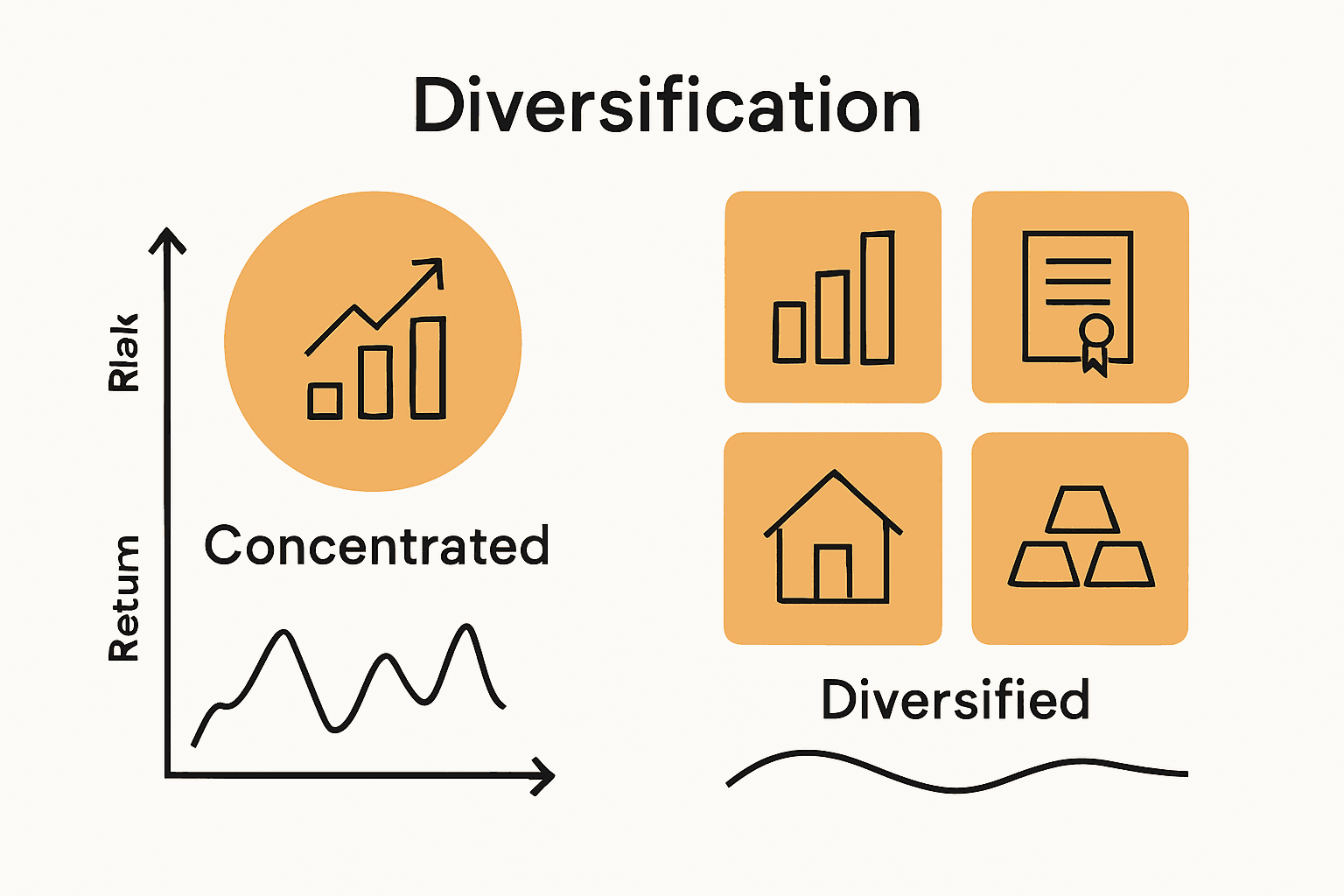Over 80 percent of american investors believe that a strong portfolio requires more than just picking a handful of popular stocks. Understanding investment diversification has become crucial for anyone seeking to weather market ups and downs and pursue long-term growth. This guide unpacks the core principles and practical strategies of diversification, helping you make smarter choices and avoid common missteps that can cost you both time and money.
Table of Contents
- Defining Investment Diversification Fundamentals
- Major Types of Diversification Strategies
- Core Benefits of Diversifying Investments
- Risks and Limitations to Diversification
- Common Diversification Mistakes to Avoid
Key Takeaways
| Point | Details |
|---|---|
| Investment Diversification | Spreading investments across various asset classes reduces financial risk and stabilizes long-term returns. |
| Diversification Strategies | Employ concentric, horizontal, vertical, and conglomerate strategies based on risk tolerance and market understanding. |
| Benefits of Diversification | A diversified portfolio leads to reduced volatility, enhanced stability, and potential for growth across different market conditions. |
| Common Mistakes | Avoid over-diversification and failing to rebalance your portfolio, as these can dilute returns and increase complexity. |
Defining Investment Diversification Fundamentals
Investment diversification represents a strategic approach to managing financial risk by spreading investments across multiple asset classes, sectors, and geographic regions. According to research from interactive.cornish.edu, this technique is fundamental to Modern Portfolio Theory (MPT), which demonstrates how intelligent allocation can optimize potential returns while minimizing potential losses.
At its core, diversification functions like a risk management safety net. By allocating investments across different financial instruments – such as stocks, bonds, real estate, and commodities – investors can protect themselves against significant downturns in any single market segment. Building an Investment Portfolio for Profits suggests that a well-diversified portfolio acts as a buffer against market volatility, ensuring more stable long-term financial performance.
The key principles of investment diversification include:
- Spreading investments across different asset classes
- Balancing high-risk and low-risk investments
- Regularly rebalancing portfolio allocations
- Considering global and local market opportunities
- Understanding individual risk tolerance
Professional investors recognize that true diversification goes beyond simply owning multiple stocks. It requires strategic thinking, consistent monitoring, and a nuanced understanding of how different investments interact within a comprehensive financial strategy. By embracing these fundamental principles, investors can build resilient portfolios designed to weather economic uncertainties and generate sustainable growth.


Major Types of Diversification Strategies
Investment diversification strategies are crucial tools for managing financial risk and creating robust investment portfolios. GeeksforGeeks outlines four primary diversification approaches that investors can leverage to optimize their financial performance: concentric, horizontal, vertical, and conglomerate diversification strategies.
The concentric diversification strategy involves investing in related industries or sectors that share technological, production, or marketing synergies. This approach allows investors to leverage existing knowledge and expertise while expanding their investment reach. Horizontal diversification, by contrast, involves investing across different but unrelated industries, which helps spread risk by ensuring that economic challenges in one sector won’t devastate the entire portfolio.
According to IAJournals, the remaining two diversification strategies offer unique advantages:
- Vertical diversification: Focuses on investments across different stages of production or supply chain
- Conglomerate diversification: Involves investing in completely unrelated businesses or sectors
Successful investors understand that selecting the right diversification strategy depends on individual risk tolerance, financial goals, and market understanding. By carefully analyzing and implementing these strategies, investors can create resilient portfolios capable of generating consistent returns while minimizing potential losses across various economic conditions.
Core Benefits of Diversifying Investments
Investment diversification offers a strategic approach to protecting and growing wealth by spreading financial resources across multiple investment vehicles. ABacademies highlights that diversification is crucial for investors seeking long-term financial success, providing a robust mechanism to optimize returns while minimizing potential risks.
The primary benefits of diversification extend far beyond simple risk reduction. According to Accounting Insights, strategic diversification enables investors to effectively mitigate potential losses by distributing investments across various assets, sectors, and geographic regions. This approach ensures that adverse events in one market segment won’t catastrophically impact the entire investment portfolio.
Key advantages of investment diversification include:


- Reduced overall portfolio volatility
- Protection against market downturns
- Potential for more consistent returns
- Enhanced ability to capitalize on multiple market opportunities
- Improved long-term financial stability
How to Diversify Investments for Financial Security suggests that successful diversification requires ongoing analysis and strategic reallocation. By continuously monitoring and adjusting investment strategies, investors can create resilient portfolios designed to weather economic uncertainties while generating sustainable growth across different market conditions.
Risks and Limitations to Diversification
Portfolio diversification, while widely recommended, is not a guaranteed strategy for investment success. IIARDJournals reveals that diversification comes with inherent challenges, including potential reduced returns and increased complexity in managing multiple investment instruments.
International diversification introduces additional layers of complexity and risk. According to TJAES, investors must carefully consider factors like currency fluctuations, geopolitical uncertainties, and varying market regulations when expanding their portfolios across global markets. These international investment nuances can significantly impact overall portfolio performance and require sophisticated understanding.
Key risks and limitations of diversification include:
- Potential for diminished investment returns
- Increased transaction and management costs
- Complexity of tracking multiple investments
- Reduced ability to capitalize on high-performing individual assets
- Potential for overextension and diluted investment focus
Investment Portfolio Basics Guide emphasizes that while diversification is crucial, investors must remain strategic and intentional. Blindly spreading investments without careful analysis can lead to suboptimal performance. Successful diversification requires continuous monitoring, periodic rebalancing, and a deep understanding of individual investment goals and risk tolerance.
Common Diversification Mistakes to Avoid
Investors frequently encounter critical pitfalls when attempting to diversify their investment portfolios. DYD highlights that over-diversification is one of the most common mistakes, where investors spread their resources so thinly that potential returns become diluted and management becomes unnecessarily complex.
Another significant error is the lack of strategic asset allocation. Many investors mistakenly believe that simply owning multiple investments constitutes true diversification. However, effective diversification requires thoughtful selection of assets with different risk profiles, performance characteristics, and potential correlation. Simply accumulating investments without understanding their underlying relationships can create a false sense of security.
Key diversification mistakes investors should avoid include:
- Blindly following market trends without personal research
- Neglecting to rebalance portfolio periodically
- Concentrating too heavily in familiar or comfortable sectors
- Ignoring correlation between different investment types
- Failing to consider individual risk tolerance
Safe Investment Options for Your Financial Future suggests that successful diversification requires continuous learning and adaptability. Investors must remain vigilant, regularly assess their portfolio’s performance, and be willing to make strategic adjustments as market conditions and personal financial goals evolve.
Secure Your Financial Future with Smart Diversification
Understanding the challenges of effective investment diversification is the first step toward protecting your wealth from market volatility and unexpected downturns. This article discusses common pitfalls like over-diversification, neglecting portfolio rebalancing, and underestimating risks linked to international markets. If you have struggled with balancing high-risk and low-risk assets or found it difficult to monitor a complex portfolio you are not alone. Many investors face these exact concerns when trying to build resilient portfolios that generate consistent returns.
At finblog.com, we specialize in helping serious investors like you master strategic diversification. Our expert insights and personalized consulting services focus on optimizing allocation strategies, avoiding costly mistakes, and adapting investments to your unique risk tolerance and goals. Don’t wait until market uncertainty threatens your financial stability. Take charge today by exploring our Safe Investment Options for Your Financial Future and learning how to Build an Investment Portfolio for Profits. Visit finblog.com now to get started on transforming your investment strategy with confidence.
Frequently Asked Questions
What is investment diversification?
Investment diversification is a strategy that involves spreading investments across various asset classes, sectors, and geographic regions to manage financial risk and optimize potential returns.
Why is diversification important in investing?
Diversification is important because it acts as a safety net against significant downturns in any single market segment, helping to reduce overall portfolio volatility and providing more stable long-term financial performance.
What are common diversification strategies?
Common diversification strategies include concentric diversification (investing in related industries), horizontal diversification (investing in unrelated industries), vertical diversification (across different production stages), and conglomerate diversification (investing in completely unrelated businesses).
What mistakes should I avoid when diversifying my investments?
Key mistakes to avoid include over-diversification, lack of strategic asset allocation, failing to regularly rebalance your portfolio, concentrating too heavily in familiar sectors, and ignoring the correlation between different types of investments.










